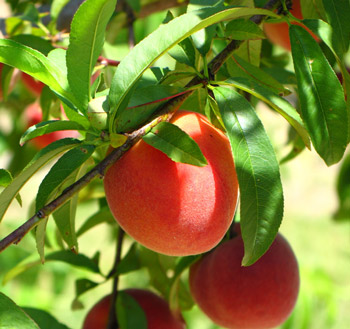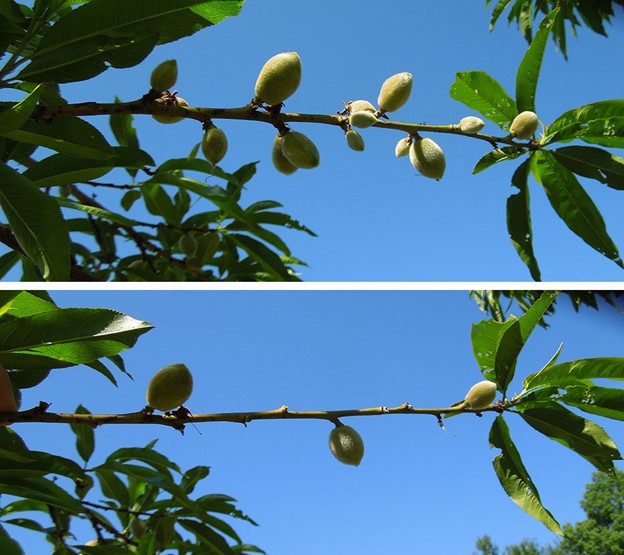Thinning Fruit on Trees
Searcy, Ark. –
 Fruit trees grown under favorable conditions set more fruit than can be properly developed.
The practice of fruit thinning contributes to your orchard’s success. It is recommended
for apples, pears, nectarines, plums, and peaches.
Fruit trees grown under favorable conditions set more fruit than can be properly developed.
The practice of fruit thinning contributes to your orchard’s success. It is recommended
for apples, pears, nectarines, plums, and peaches.
As a county agent, I find it difficult to convince people to thin their fruit trees. However, there are several reasons why fruit crops should be thinned. A portion of the fruit is removed so that the remainder will develop adequate size. Thinning of fruit balances the amount of fruit left on trees with the leaf surface that provides the energy to grow and ripen fruit.
Top 3 Reasons to Thin Fruit on Trees
- Leaving too much fruit on a tree creates a burden for the tree and takes energy from
other processes occurring at the time of fruit development. One of those processes
is fruit bud development for the coming crop. When too much fruit is left on a tree,
fruit bud production for next year will be limited, causing the tree to have a light
crop next year.
- Thinning increases the plant’s ability to form flower buds for the next year, provided
the thinning is done early enough. Failure to thin can lead to biennial bearing problems
i.e., over-production one year followed by a year of extremely low yields.
- A third reason to thin fruit is to reduce limb breakage that occurs when too much fruit is left, and the fruit begins to size. Finally, insects and disease are more difficult to control when fruit hang in clusters.
Hand thinning is the easiest and safest method for removing excess fruit. Begin hand thinning when the fruits are about ½ inch in diameter. Start at one end of a branch and systematically remove fruit, leaving one fruit every 6 to 8 inches. Keep in mind that only 5% to 10% of the tree’s flowers are needed to set a full crop of fruit.
How do I thin the fruit on my tree?

When choosing which fruit to leave look for the largest fruit. Fruit that is small
or damaged should be dropped first. If you have twins or triplets only keep a single
fruit. Homeowners should thin fruit as early as possible, or within the first 20-30
days after petal fall. Removing these small fruits early will keep energy available
for the fruit that remains and fruit buds for next year.
Orchard floor sanitation is very important in maintaining healthy fruit trees. Fungal
pathogens over-winter on dried leaves, pruned limbs, and decaying fruit left on the
orchard floor. Fungal spores produced on the leaves and limbs left on the orchard
floor can inoculate healthy trees and fruit in the spring when temperatures are warmer
and rain, irrigation water and wind spread the spores. Diseased branches that have
been pruned need to be disposed of as soon as possible. Thinned fruit needs to be
removed from the orchard floor.
As the fruit matures and branches begin to bend from the weight you may need to take more fruit off each limb to protect your tree from limb breakage, especially when the tree is young. If you do not want to thin more fruit from the tree limbs you may need to use poles or props to hold up the limbs.
Remember when raising dwarf fruit trees to thin a little extra fruit off after bloom because the tree is not as strong structurally as a semi-dwarf or standard tree. Dwarf fruit trees are precocious and tend to bloom and set heavier fruit crops at an early age. Protect their young branches from being overloaded in the first few years.
What about pruning?
I always recommend pruning annually. Pruning helps to maintain a healthy tree by removing wood that contributes to over fruiting. Pruning is the first stage of fruit thinning. Without proper pruning fruit thinning is not a feasible practice.
See our fruit tree pruning tips
Additional Resources
By Sherri Sanders
White County Extension Agent - Agriculture
U of A Division of Agriculture
Cooperative Extension Service
2400 Old Searcy Landing Road Searcy AR 72143
(501) 268-5394
ssanders@uada.edu